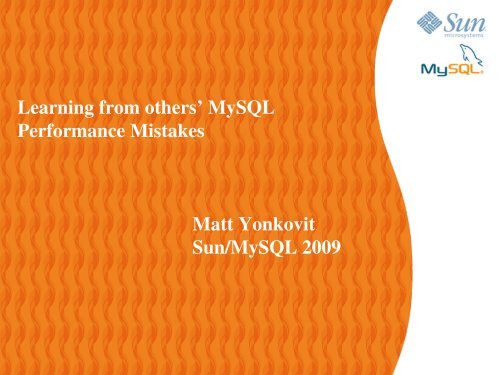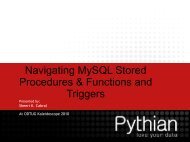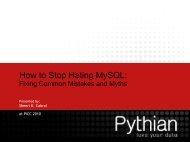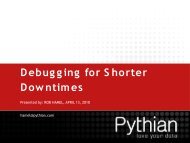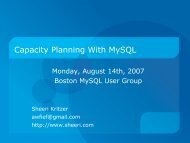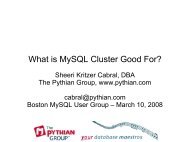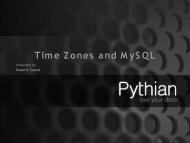'xxx' where
'xxx' where
'xxx' where
Create successful ePaper yourself
Turn your PDF publications into a flip-book with our unique Google optimized e-Paper software.
Learning from others’ MySQL<br />
Performance Mistakes<br />
Matt Yonkovit<br />
Sun/MySQL 2009<br />
SUN MICROSYSTEMS COMPANY CONFIDENTIAL SUN MICROSYSTEMS COPYRIGHT 2009
The Same Old Thing<br />
•We tend to get the same issues over and over<br />
again<br />
•Customers face similar challenges<br />
•Some fixes are very easy and we need to<br />
promote common knowledge<br />
SUN MICROSYSTEMS COMPANY CONFIDENTIAL SUN MICROSYSTEMS COPYRIGHT 2009
Lets be honest though<br />
• Sometimes applications are like<br />
Forest Gump...<br />
• They start off small and<br />
unassuming, 1 server and 2<br />
guys workings hard , people<br />
laugh at them...<br />
• Then overnight they become<br />
really successful and busy<br />
• What worked before doesn't<br />
work you need more shrimp<br />
boats!!!!<br />
SUN MICROSYSTEMS COMPANY CONFIDENTIAL SUN MICROSYSTEMS COPYRIGHT 2009
Top 10 Repeats<br />
1. More is not always better<br />
2. Text fields can be bad<br />
3. Size ( data size ) does matter<br />
4. Type Comparison<br />
• Left Outer joins<br />
• The Solo Index<br />
• Always an IO Problem<br />
• Filesystem and Lun Layout<br />
• No Black Box<br />
• Self-induced fragmentation<br />
SUN MICROSYSTEMS COMPANY CONFIDENTIAL SUN MICROSYSTEMS COPYRIGHT 2009
More is not always better<br />
•People go hog wild on per thread buffers like<br />
read_buffer, read_rnd_buffer, join_buffer, and<br />
sort_buffer.<br />
•Try to reserve a minimum of 4GB for the OS<br />
and per thread buffers, more if you know you<br />
have a lot of threads ( 8GB ).<br />
•Setting these too high can cause bad things<br />
to happen. Too many times I see systems<br />
swapping.<br />
•Interesting memory issues when buffers are<br />
set to high<br />
SUN MICROSYSTEMS COMPANY CONFIDENTIAL SUN MICROSYSTEMS COPYRIGHT 2009
Malloc -vs- mmap<br />
• Back in 2007, we ran into a performance issue when<br />
the read_buffer was set to more then 256K.<br />
Internally Malloc is used to allocate memory when<br />
the read_buffer is set to less then 256K, when this is<br />
set higher mmap is used to allocate memory. What's<br />
the difference?<br />
From Monty's blog he put together a quick program to test how<br />
long it takes for malloc to allocate memory ( total for 100K ) :<br />
Time for 128k: 0.035105<br />
Time for 256k: 0.028631<br />
Time for 1024k: 0.942634<br />
Time for 5120k: 0.985856<br />
SUN MICROSYSTEMS COMPANY CONFIDENTIAL SUN MICROSYSTEMS COPYRIGHT 2009
Monty's oprofile<br />
OPROFILE<br />
CPU with 5MB read_buffer<br />
561612 25.0417 /lib64/tls/libc-2.3.4.so memset<br />
429457 19.1491 /usr/lib/debug/lib/modules/2.6.9-34.ELsmp/vmlinux clear_page<br />
214268 9.5540 /usr/lib/debug/lib/modules/2.6.9-34.ELsmp/vmlinux do_page_fault<br />
144293 6.4339 /usr/lib/debug/lib/modules/2.6.9-34.ELsmp/vmlinux do_no_page<br />
94410 4.2097 /usr/lib/debug/lib/modules/2.6.9-34.ELsmp/vmlinux buffered_rmqueue<br />
64998 2.8982 /lib64/tls/libc-2.3.4.so memcpy<br />
CPU with 128K read_buffer<br />
2220 15.7760 /lib64/tls/libc-2.3.4.so memset<br />
785 5.5785 /lib64/tls/libc-2.3.4.so memcpy<br />
608 4.3206 /usr/lib/debug/lib/modules/2.6.9-34.ELsmp/vmlinux thread_return<br />
398 2.8283 /usr/libexec/mysqld yyparse(void*)<br />
337 2.3948 /usr/lib/debug/lib/modules/2.6.9-34.ELsmp/vmlinux system_call<br />
“The results on the system as a whole were that with read buffer set to 5M, extra 3-5% usr<br />
and 6-12% sys cpu time taken on an 8 cpu box (as reported by top) or, to look at it another<br />
way, about 100% of a single CPU taken by mysqld.”<br />
SUN MICROSYSTEMS COMPANY CONFIDENTIAL SUN MICROSYSTEMS COPYRIGHT 2009
Don't leave them as default either!<br />
• Don't leave the my.cnf as default configs either!<br />
– Minimally set:<br />
Innodb buffer pool<br />
Key Buffer<br />
Query cache<br />
Trx commit<br />
• The sample my.cnf are just samples!<br />
• I have some better examples on bigdbahead.com<br />
SUN MICROSYSTEMS COMPANY CONFIDENTIAL SUN MICROSYSTEMS COPYRIGHT 2009
Swap?<br />
•Despite what really smart people say... don't<br />
turn off swap... slow or dead?<br />
•Whats your swapiness? Cat<br />
/proc/sys/vm/swappiness<br />
•Carefully manage your memory to avoid<br />
swap...<br />
SUN MICROSYSTEMS COMPANY CONFIDENTIAL SUN MICROSYSTEMS COPYRIGHT 2009
Text Fields<br />
•Many clients do not realize that text fields<br />
and varchars have the same max size (64K)<br />
•Text fields have to use temporary tables on<br />
disk, while varchars can use memory based<br />
temporary tables<br />
•Distinct, aggregates, group by, order by can<br />
all cause excessive disk utilization due to<br />
temp tables.<br />
•Ruby and the select *<br />
SUN MICROSYSTEMS COMPANY CONFIDENTIAL SUN MICROSYSTEMS COPYRIGHT 2009
Data Size Matters<br />
• Thin is in!<br />
• Smaller datatypes mean less storage on disk<br />
• Less storage per row means faster retrieval of rows<br />
• Less storage per row means more rows fit into memory<br />
• Size especially matters with innodb PK's!<br />
– PK's are clusters indexes<br />
– Every subsequent index contains the PK!<br />
SUN MICROSYSTEMS COMPANY CONFIDENTIAL SUN MICROSYSTEMS COPYRIGHT 2009
Data type size<br />
Data size effects disk utilization as well as memory.<br />
DataType bytes size Prefered bytes DataType size<br />
datetime 8 bytes timestamp4 bytes<br />
seconds since<br />
epoch (up to 2038)<br />
Unsigned Up to:<br />
Unsigned Up to:<br />
bigint 8 bytes 18,446,744,073,709,551,615 int 4 bytes 4,294,967,295<br />
text variable up to 65,535 varchar variable up to 65,535<br />
float 4 bytes Decimal variable<br />
double 8 bytes Decimal variable<br />
People index the full varchar fields, end up with key sizes of<br />
300bytes or more<br />
SUN MICROSYSTEMS COMPANY CONFIDENTIAL SUN MICROSYSTEMS COPYRIGHT 2009
General data type reminders<br />
• Avoid floats when not needed<br />
• Remember to unsign variables when need be<br />
• People still think int(1) means 1 byte or one digit<br />
• Don't forget Enums<br />
• Bigints as 64 bit masks? Avoid it, really dumb.<br />
• Datetime is 8 bytes, date/time separate columns is<br />
6...<br />
• Ip varchars of doom... use INET_ATON()<br />
• Hash values sometimes better for indexes<br />
• Not null can save space... why are you allowing<br />
nullables?<br />
SUN MICROSYSTEMS COMPANY CONFIDENTIAL SUN MICROSYSTEMS COPYRIGHT 2009
Avoid Needless data conversions<br />
• DON'T convert column data with functions, avoid something like :<br />
– Select * from users <strong>where</strong> lower(name) = 'matt'<br />
– This will negate the use of an index on name<br />
– Consider inserting data with with the function, or use a case insensitive<br />
collation<br />
• If you are building a higher performance system avoid implicate<br />
conversions of strings to ints... more on next slide.<br />
• If your going to store numbers don't use a char or varchar<br />
SUN MICROSYSTEMS COMPANY CONFIDENTIAL SUN MICROSYSTEMS COPYRIGHT 2009
Time to convert datatypes...<br />
• Implicit conversion of data types wastes resources... some small some<br />
large...<br />
Single quote of integer is small overhead, but in a really busy system this can add<br />
up... below my benchmark shows < 1 ms difference in runtimes. You would<br />
save 11 seconds per 100K queries... but in a busy system you may have millions<br />
of queries per minute.<br />
mysql> select qryid, note, avg(averagequeryruntime), count(*), querytext from Logger_single group by qryid, note;<br />
+-------+-------------------+--------------------------+----------+--------------------------------------------------------+<br />
| qryid | note | avg(averagequeryruntime) | count(*) | querytext |<br />
+-------+-------------------+--------------------------+----------+--------------------------------------------------------+<br />
| 1 | 1 file no restart | 0.00042705535888672 | 210 | select * from fragtest.test_frag1 <strong>where</strong> id = 30718; |<br />
| 2 | 1 file no restart | 0.00052125908079601 | 210 | select * from fragtest.test_frag1 <strong>where</strong> id = '30718'; |<br />
| 3 | 1 file no restart | 0.00041392644246419 | 210 | select * from fragtest.test_frag1 <strong>where</strong> id = 90718; |<br />
| 4 | 1 file no restart | 0.00052596046811058 | 210 | select * from fragtest.test_frag1 <strong>where</strong> id = '90718'; |<br />
+-------+-------------------+--------------------------+----------+--------------------------------------------------------+<br />
4 rows in set (0.02 sec)<br />
A system issuing 100K selects per minute would save 4.5 hours of CPU time each<br />
day ( or 19% of 1 cpu ) by not using single qoutes! That scales up, 200K selects<br />
is 9 hours of CPU, @1 million selects a minute you would save 45 hours, which is<br />
almost 2 full CPU's.<br />
SUN MICROSYSTEMS COMPANY CONFIDENTIAL SUN MICROSYSTEMS COPYRIGHT 2009
Type Comparison<br />
Every knows that if you miss enclosing a character reference in a select statement it<br />
will complain. For instance:<br />
mysql> explain select * from MyTest <strong>where</strong> name =matt;<br />
ERROR 1054 (42S22): Unknown column ‘matt’ in ‘<strong>where</strong> clause’<br />
But what most miss is this is not always the case:<br />
mysql> explain select * from MyTest <strong>where</strong> name =1234;<br />
+—-+————-+——–+——+—————+——+———+——+——+————-+<br />
| id | select_type | table | type | possible_keys | key | key_len | ref | rows | Extra |<br />
+—-+————-+——–+——+—————+——+———+——+——+————-+<br />
| 1 | SIMPLE | MyTest | ALL | myidx | NULL | NULL | NULL | 1 | Using <strong>where</strong> |<br />
+—-+————-+——–+——+—————+——+———+——+——+————-+<br />
The impact of this can be huge, I was at a client who used a varchar as a PK on a table (<br />
bad by itself ). All the values in the varchar field <strong>where</strong><br />
numeric, but all the statements coming from the application used unescaped integers<br />
to within the SQL statement ( i.e. id = 123 instead of id = ‘123′ ).<br />
This has the unfortunate side effect of bypassing the index, which in this extreme case<br />
meant no PK access … which was very, very bad.<br />
SUN MICROSYSTEMS COMPANY CONFIDENTIAL SUN MICROSYSTEMS COPYRIGHT 2009
Left Outer Joins<br />
One of the big pet peeves of mine is looking through thousands of SQL<br />
statements and seeing everyone of the statements is doing a left outer<br />
join. My Absolute favorite is something like this:<br />
select a.var, b.var from a left join b on a.id=b.id <strong>where</strong> b.var =<br />
‘xxx’ ….<br />
aid bid avar bvar<br />
1 1 xxx xxx<br />
2 2 xxx xxx<br />
3 NULL xxx NULL<br />
4 NULL xxx NULL<br />
folks if you set the value of a column in the b table your left join is<br />
meaningless, think about it… if the ids do not match the b side will all<br />
return null… a null b.var will be filtered out. What you probably want is:<br />
select a.var, b.var from a left join b on a.id=b.id and b.var = ‘xxx’<br />
<strong>where</strong> ….<br />
SUN MICROSYSTEMS COMPANY CONFIDENTIAL SUN MICROSYSTEMS COPYRIGHT 2009
Left Joins 2<br />
Also … another little left join nugget. I don;t know why but several folks<br />
have done this type of an operation:<br />
select a.var1, a.var2 from a left join b on a.id=b.id <strong>where</strong> a.var1<br />
= ‘xxx’<br />
The question is what is the benefit of joining to b?<br />
aid bid avar bvar<br />
1 1 xxx xxx<br />
2 2 xxx xxx<br />
3 NULL xxx NULL<br />
4 NULL xxx NULL<br />
My favorite argument of left join happy shops is, well we put it in there<br />
just in case we missed something… enough said.<br />
Be Aware hibernate loves left joins!!<br />
SUN MICROSYSTEMS COMPANY CONFIDENTIAL SUN MICROSYSTEMS COPYRIGHT 2009
Mixing Storage engines<br />
• Splitting half the tables between MyIsam and innodb<br />
is always a bad idea<br />
– Get the worst of both worlds<br />
– Config must split memory<br />
SUN MICROSYSTEMS COMPANY CONFIDENTIAL SUN MICROSYSTEMS COPYRIGHT 2009
Indexing Tips<br />
• AVOID THE Solo index on every column<br />
– Seen 3 or 4 clients do this...<br />
– Every column has a single index<br />
– Too many indexes slow down inserts/updates<br />
– Bloat memory<br />
– Bloat disk<br />
– Index merges can happen in some cases, but they<br />
are slower then multiple key indexes<br />
• Remove redundant indexes<br />
– KEY ( id ) and KEY ( id, type ) are redundant!<br />
• Run explain!<br />
SUN MICROSYSTEMS COMPANY CONFIDENTIAL SUN MICROSYSTEMS COPYRIGHT 2009
PK Innodb & Disk<br />
• Use Small Pks, remember data size!<br />
• Remember the order of the PK = Disk sorted order<br />
• Huge performance improvement 20x at customer<br />
• Don't always use auto-increment... or put it at the<br />
end.<br />
SUN MICROSYSTEMS COMPANY CONFIDENTIAL SUN MICROSYSTEMS COPYRIGHT 2009
IO issues<br />
One of my goals in almost any engagement is to<br />
reduce the amount of data being read from or<br />
written to disk... why?<br />
Because it's almost always an IO issue ( most of<br />
the time anyway )<br />
SUN MICROSYSTEMS COMPANY CONFIDENTIAL SUN MICROSYSTEMS COPYRIGHT 2009
Is it always an IO Problem?<br />
• Yes...<br />
• Because wiki is 100% accurate:<br />
– In computing, input/output, or I/O, refers to the<br />
communication between an information processing system<br />
(such as a computer), and the outside world – possibly a<br />
human, or another information processing system. Inputs are<br />
the signals or data received by the system, and outputs are<br />
the signals or data sent from it. The term can also be used as<br />
part of an action; to "perform I/O" is to perform an input or<br />
output operation.<br />
• In order to make Forrest run faster we need to fix his<br />
IO!<br />
SUN MICROSYSTEMS COMPANY CONFIDENTIAL SUN MICROSYSTEMS COPYRIGHT 2009
Let’s Clarify some more<br />
• IO is not just disk! Disk is just the rear end...<br />
• IO is transfer data around the various inards of a<br />
computer, much like: ( Yes I am comparing IO to the<br />
digestive system )<br />
SUN MICROSYSTEMS COMPANY CONFIDENTIAL SUN MICROSYSTEMS COPYRIGHT 2009
Consider<br />
• These are all IO issues:<br />
– The lines at your local amusement park<br />
– Disks can not retrieve blocks fast enough, and have to wait<br />
for huge queues to be cleared<br />
– Too much bloat in memory is causing in memory operations<br />
to take 100 nanoseconds instead of 40 nanoseconds. ( not a<br />
cpu bottleneck even though CPU may be maxed out )<br />
– The network throughput is maxed out, why? Because<br />
someone is retrieving millions of rows... network is not bad ...<br />
– There is more....<br />
SUN MICROSYSTEMS COMPANY CONFIDENTIAL SUN MICROSYSTEMS COPYRIGHT 2009
Reduce!!!!!<br />
• IO requires a killer diet on most systems... ( and I<br />
could use one too )<br />
– Reducing data size helps!<br />
– Reducing what your asking for helps even more<br />
– Stored procs may help... keep the data local<br />
– Pre-summarize<br />
• Along with diets you need exercise:<br />
– Faster pieces can help, cpu, memory, disk<br />
– But like a me, even if I work out... I can not just eat crap<br />
food.<br />
SUN MICROSYSTEMS COMPANY CONFIDENTIAL SUN MICROSYSTEMS COPYRIGHT 2009
Always an IO Problem?<br />
• Spindles not Capacity! Clients often estimate how<br />
much space they need, but rarely how many IOPS!<br />
Look how disk performance impacts DB performance:<br />
SUN MICROSYSTEMS COMPANY CONFIDENTIAL SUN MICROSYSTEMS COPYRIGHT 2009
All about concurrency<br />
• Many benchmarks, other people test throughput with<br />
1 thread, who has a database that does only one<br />
thing?<br />
• Todays databases demand high concurrency, disk is<br />
key to this...<br />
• Disk arm movement ends up killing performance...<br />
• The 7:30am client call.... 50 load average, 600ms<br />
disk time, from 500 users to 1000.<br />
SUN MICROSYSTEMS COMPANY CONFIDENTIAL SUN MICROSYSTEMS COPYRIGHT 2009
Concurrency Matters!<br />
SUN MICROSYSTEMS COMPANY CONFIDENTIAL SUN MICROSYSTEMS COPYRIGHT 2009
Filesystem & LUN layout<br />
•Swap and MySQL on the same LUN is BAD!<br />
– Asking for performance issues<br />
•/var/log and /tmp on the same Lun as mysql is<br />
bad<br />
– /tmp filling up can freeze the database<br />
– Log flling up can freeze the database<br />
•Best with its own separate disks.<br />
SUN MICROSYSTEMS COMPANY CONFIDENTIAL SUN MICROSYSTEMS COPYRIGHT 2009
SAN != Black Box<br />
•San is not a black box!<br />
•Emc technology prime example: Moves hot<br />
data around... lots of cache, should never be<br />
an issue<br />
SUN MICROSYSTEMS COMPANY CONFIDENTIAL SUN MICROSYSTEMS COPYRIGHT 2009
Self-induced fragmentation<br />
• What happens when you have a 20GB table, but have<br />
multiple 2GB datafiles?<br />
• What the separate data files do is they introduce selfinduced<br />
fragmentation. When you go to scan the<br />
table you now have to potentially scan through 20<br />
files instead of 1 file. This also potentially will disrupt<br />
the “clustered index” advantage that innodb<br />
provides.<br />
• I put together some tests to show this:<br />
SUN MICROSYSTEMS COMPANY CONFIDENTIAL SUN MICROSYSTEMS COPYRIGHT 2009
Test Setup<br />
I created 4 identical tables with the following definitions:<br />
CREATE TABLE `test_frag1` (<br />
`id` int(11) NOT NULL AUTO_INCREMENT,<br />
`name` varchar(300) DEFAULT NULL,<br />
`address` varchar(1000) DEFAULT NULL,<br />
`state` char(2) DEFAULT NULL,<br />
`val1` int(11) DEFAULT NULL,<br />
`val2` int(11) DEFAULT NULL,<br />
`val3` int(11) DEFAULT NULL,<br />
`val4` int(11) DEFAULT NULL,<br />
`val5` int(11) DEFAULT NULL,<br />
PRIMARY KEY (`id`),<br />
KEY `name_idx` (`name`),<br />
KEY `val_idx` (`val1`,`val2`)<br />
) ENGINE=InnoDB AUTO_INCREMENT=1039773 DEFAULT CHARSET=latin1<br />
SUN MICROSYSTEMS COMPANY CONFIDENTIAL SUN MICROSYSTEMS COPYRIGHT 2009
Test Setup (continue)<br />
I loaded the data in the four tables 1 record at a time, alternating tables. I then went back<br />
and updated 10% the data to ensure a somewhat realistic dataset and fragmentation.<br />
I then ran a sampling of the following queries:<br />
1 select * from fragtest.test_frag1 <strong>where</strong> id = ‘30718′;<br />
2 select * from fragtest.test_frag1 <strong>where</strong> val1 < 1000 limit 1,1;<br />
3 select * from fragtest.test_frag1 <strong>where</strong> id = 90718;<br />
4 select count(*), sum(val1), sum(val2), avg(val3) from fragtest.test_frag1 <strong>where</strong> val4 < 10000;<br />
5 select sum(val4+val5) from fragtest.test_frag2;<br />
6 select * from fragtest.test_frag3 <strong>where</strong> val1=5718;<br />
7 select * from fragtest.test_frag4 <strong>where</strong> val1> 5700 and val2 < 10000 and val3 =14242;<br />
8 select count(*), sum(val1), sum(val2), avg(val3) from fragtest.test_frag1<br />
<strong>where</strong> state in (94,84,35,36,11,12,99,50) group by state ;<br />
9 select * from fragtest.test_frag3 a, fragtest.test_frag1 b <strong>where</strong> a.val1 = b.id and a.id = 1111;<br />
10 select * from fragtest.test_frag2 a, fragtest.test_frag4 b <strong>where</strong> a.val1 = b.id and b.id = 9690;<br />
11 select sum(a.val2) from fragtest.test_frag2 a, fragtest.test_frag4 b <strong>where</strong> a.val1 = b.id<br />
and b.id = 999;<br />
SUN MICROSYSTEMS COMPANY CONFIDENTIAL SUN MICROSYSTEMS COPYRIGHT 2009
Test Setup (continue)<br />
• I dropped the top and bottom 5% to ensure no skewed tests:<br />
Query ID 1 Innodb File 40 Innodb files DIFF x<br />
1 0.0103 0.0159 53.53%<br />
2 0.0567 0.0478 15.72%<br />
3 0.0205 0.0226 10.16%<br />
4 7.0861 7.6782 8.36%<br />
5 7.8960 8.4054 6.45%<br />
6 3.7241 3.7422 0.49%<br />
7 8.3528 9.2764 11.06%<br />
8 7.0573 7.7802 10.24%<br />
9 0.0468 0.0505 8.05%<br />
10 1.3608 1.3966 2.64%<br />
11 0.0211 0.0262 24.14%<br />
SUN MICROSYSTEMS COMPANY CONFIDENTIAL SUN MICROSYSTEMS COPYRIGHT 2009
Customer Example<br />
• This seriously effects clients performance.<br />
• They have over 100 2GB datafiles.... just craziness!<br />
SUN MICROSYSTEMS COMPANY CONFIDENTIAL SUN MICROSYSTEMS COPYRIGHT 2009
Summary<br />
• Avoid the same mistakes and issues your IT brethren<br />
have done!<br />
Want more?<br />
Read more at bigdbahead.com!<br />
Stop by and see me give this lecture in person at the<br />
MySQL Camp at the user conference<br />
Or better yet stop by and see my sessions on Solid State disk<br />
& Waffle Grid!<br />
SUN MICROSYSTEMS COMPANY CONFIDENTIAL SUN MICROSYSTEMS COPYRIGHT 2009


